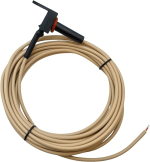- May 12, 2019
- 29
- Pool Size
- 43000
- Surface
- Plaster
- Chlorine
- Salt Water Generator
- SWG Type
- Hayward Turbo Cell (T-CELL-5)
I have seen several posts @caliskier about adding a Resister to the blue and black wires inside your TCELL to tell the control panel the Temperature and Salt levels are fine. My TCELL940 (extended life, yeah right) is only 1 year old, but started saying "Low Salt" suddenly, but I tested water and know salt level is good, so Thermiser inside TCELL must be bad. I did get a warranty replacement and all working fine again, but I don't want to toss the bad tcell thinking it should have plenty of life left but for the bad thermister. I do not run in cold weather and maintain salt levels, so I would be happy to bypass the thermister and trick it into thinking salt levels are fine and temp is fine if I can get a few more years of life out of it.
Can someone please post step-by-step instructions on how to add a Resister, link to product to order, how to install, etc? I'm no electrician but pretty handy, just need directions.
Thanks!
Can someone please post step-by-step instructions on how to add a Resister, link to product to order, how to install, etc? I'm no electrician but pretty handy, just need directions.
Thanks!
Last edited by a moderator:






